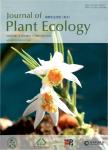The contribution of microorganisms and metazoans to mineral nutrition in bromeliads
作者机构:IRDUMR AMAP(botAnique et Modélisation de l’Architecture des Plantes et des végétations)Boulevard de la LirondeTA A‐51/PS2F‐34398 Montpellier Cedex 5France UMR Ecologie des Forêts de Guyane(AgroParisTechCIRADCNRSINRAUniversitéde GuyaneUniversitédes Antilles)Campus AgronomiqueBP 316F-97379 Kourou cedexFrance UniversitéClermont AuvergneUniversitéBlaise PascalBP 10448F-63000 Clermont-FerrandFrance CNRSUMR 6023Laboratoire Microorganismes:Génome et EnvironnementCampus Universitaire des Cézeaux1 impasse Amélie MuratTSA 60026 CS *** Aubière cedexFrance Universitéde ToulouseINPUPS EcoLab(Laboratoire Ecologie Fonctionnelle et Environnement)F-31062 ToulouseFrance CNRSEcoLab118 Route de NarbonneF-31062 ToulouseFrance
出 版 物:《Journal of Plant Ecology》 (植物生态学报(英文版))
年 卷 期:2016年第9卷第3期
页 面:241-255页
核心收录:
学科分类:0710[理学-生物学] 0830[工学-环境科学与工程(可授工学、理学、农学学位)] 09[农学] 0903[农学-农业资源与环境] 0901[农学-作物学] 0902[农学-园艺学] 0713[理学-生态学] 090301[农学-土壤学]
基 金:support from the Programme Convergence 2007-2013,Région Guyane from the European community(BREGA,ref.32080) an‘Investissement d’Avenir’grant managed by Agence Nationale de la Recherche(CEBA,ref.ANR-10-LABX-0025)
主 题:digestive mutualism insect-assisted nutrients leafδ15N multiple N sources myrmecotrophy
摘 要:Aims One critical challenge for plants is to maintain an adequate nutrient supply under fluctuating environmental *** is particularly true for epiphytic species that have limited or no access to the pedosphere and often live in harsh *** have evolved key innovations such as epiphytism,water-absorbing leaf trichomes,tank habit and Crassulacean acid metabolism(CAM)photosynthesis that enable them to survive under various environmental *** encompass diverse ecological types that live on different substrates(they can be terrestrial,epilithic or epiphytic)and vary in their ability to retain water(they can be tank-forming or tankless)and photosynthetic pathway(i.e.C3 or CAM).In this review,we outline the nutritional modes and specializations that enable bromeliads to thrive in a wide range of nutrient-poor(mostly nitrogen-depleted)*** FindingsBromeliads have evolved a great diversity of morphologies and functional adaptations leading to the existence of numerous nutritional *** on species that have absorptive foliar trichomes,we review evidence that bromeliads have evolved multi-faceted nutritional strategies to respond to fluctuations in the supply of natural nitrogen(N).These plants have developed mutualistic associations with many different and functionally diverse terrestrial and aquatic microorganisms and metazoans that contribute substantially to their mineral nutrition and,thus,their fitness and *** and fungal microbiota-assisted N provisioning,protocarnivory,digestive mutualisms and myrmecotrophic pathways are the main strategies used by bromeliads to acquire *** combination of different nutritional pathways in bromeliads represents an important adaptation enabling them to exploit nutrient-poor ***,as has been shown for several other vascular plants,multiple partners are involved in nutrient acquisition indicating that there have been convergent adap



